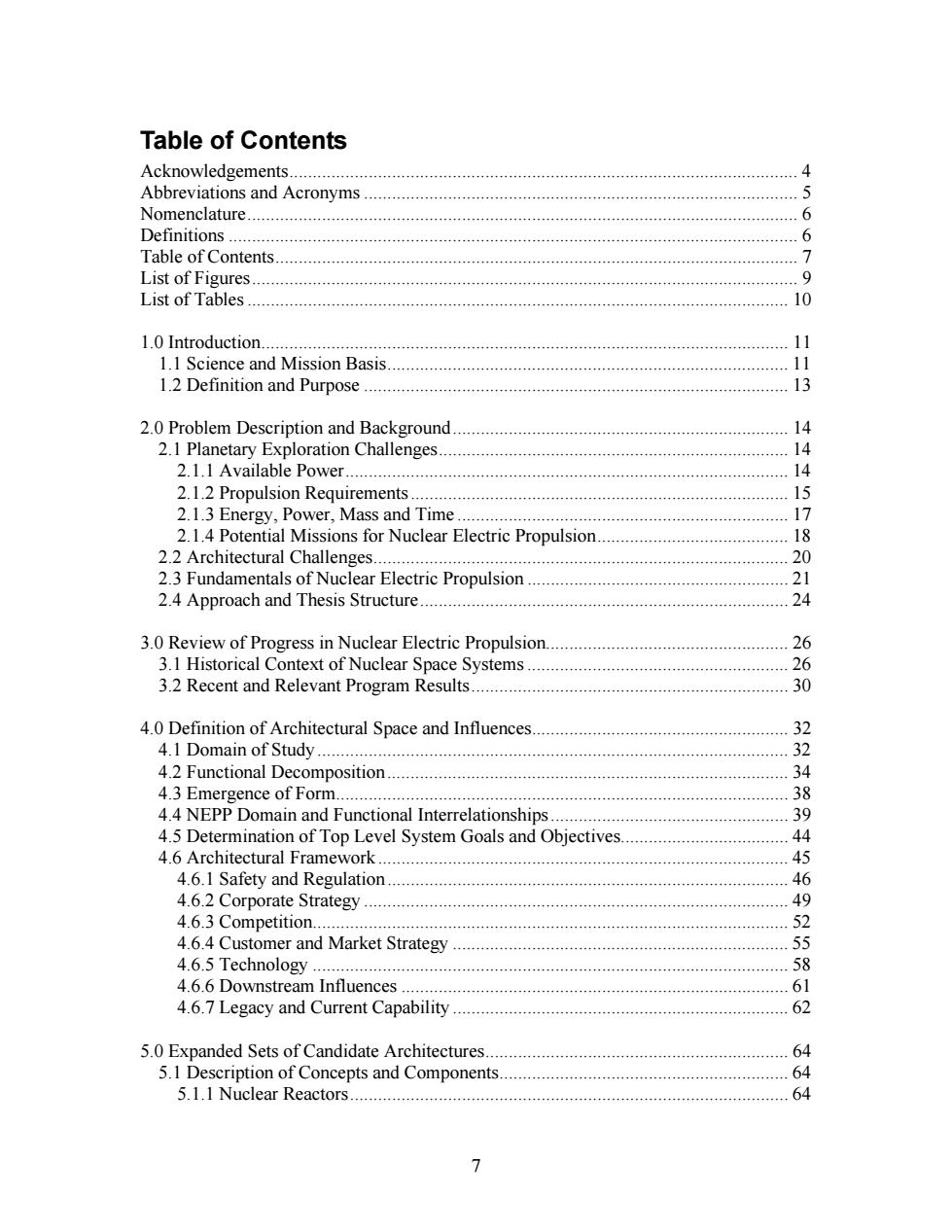
Table of Contents Acknowledgements. 4 Abbreviations and Acronyms 5 Nomenclature..... 6 Definitions..… 6 Table of Contents.… 7 List of Figures. 9 List of Tables. 10 1.0 Introduction..… 11 1.1 Science and Mission Basis............. 11 1.2 Definition and Purpose.................. 13 2.0 Problem Description and Background. 14 2.1 Planetary Exploration Challenges 14 2.1.1 Available Power............. 14 2.1.2 Propulsion Requirements.................. 15 2.1.3 Energy,Power,Mass and Time......... 17 2.1.4 Potential Missions for Nuclear Electric Propulsion. 18 2.2 Architectural Challenges..... 20 2.3 Fundamentals of Nuclear Electric Propulsion 21 2.4 Approach and Thesis Structure.............. 24 3.0 Review of Progress in Nuclear Electric Propulsion 26 3.1 Historical Context of Nuclear Space Systems....... 26 3.2 Recent and Relevant Program Results.... 30 4.0 Definition of Architectural Space and Influences.............................. 32 4.1D0main0 f Study.… 32 4.2 Functional Decomposition.. 34 4.3 Emergence of Form......... 38 4.4 NEPP Domain and Functional Interrelationships. 39 4.5 Determination of Top Level System Goals and Objectives 44 4.6 Architectural Framework................ 45 4.6.1 Safety and Regulation........... 46 4.6.2 Corporate Strategy.............. 49 4.6.3 Competition..... 52 4.6.4 Customer and Market Strategy 55 4.6.5 Technology. 58 4.6.6 Downstream Influences................... 61 4.6.7 Legacy and Current Capability............. 62 5.0 Expanded Sets of Candidate Architectures.. 64 5.1 Description of Concepts and Components. 64 5.1.1 Nuclear Reactors.............. 64
Table of Contents Acknowledgements............................................................................................................. 4 Abbreviations and Acronyms ............................................................................................. 5 Nomenclature...................................................................................................................... 6 Definitions .......................................................................................................................... 6 Table of Contents................................................................................................................ 7 List of Figures..................................................................................................................... 9 List of Tables.................................................................................................................... 10 1.0 Introduction................................................................................................................. 11 1.1 Science and Mission Basis...................................................................................... 11 1.2 Definition and Purpose ........................................................................................... 13 2.0 Problem Description and Background........................................................................ 14 2.1 Planetary Exploration Challenges........................................................................... 14 2.1.1 Available Power............................................................................................... 14 2.1.2 Propulsion Requirements................................................................................. 15 2.1.3 Energy, Power, Mass and Time ....................................................................... 17 2.1.4 Potential Missions for Nuclear Electric Propulsion......................................... 18 2.2 Architectural Challenges......................................................................................... 20 2.3 Fundamentals of Nuclear Electric Propulsion ........................................................ 21 2.4 Approach and Thesis Structure............................................................................... 24 3.0 Review of Progress in Nuclear Electric Propulsion.................................................... 26 3.1 Historical Context of Nuclear Space Systems........................................................ 26 3.2 Recent and Relevant Program Results.................................................................... 30 4.0 Definition of Architectural Space and Influences....................................................... 32 4.1 Domain of Study..................................................................................................... 32 4.2 Functional Decomposition...................................................................................... 34 4.3 Emergence of Form................................................................................................. 38 4.4 NEPP Domain and Functional Interrelationships................................................... 39 4.5 Determination of Top Level System Goals and Objectives.................................... 44 4.6 Architectural Framework........................................................................................ 45 4.6.1 Safety and Regulation...................................................................................... 46 4.6.2 Corporate Strategy ........................................................................................... 49 4.6.3 Competition...................................................................................................... 52 4.6.4 Customer and Market Strategy ........................................................................ 55 4.6.5 Technology ...................................................................................................... 58 4.6.6 Downstream Influences ................................................................................... 61 4.6.7 Legacy and Current Capability ........................................................................ 62 5.0 Expanded Sets of Candidate Architectures................................................................. 64 5.1 Description of Concepts and Components.............................................................. 64 5.1.1 Nuclear Reactors.............................................................................................. 64 7
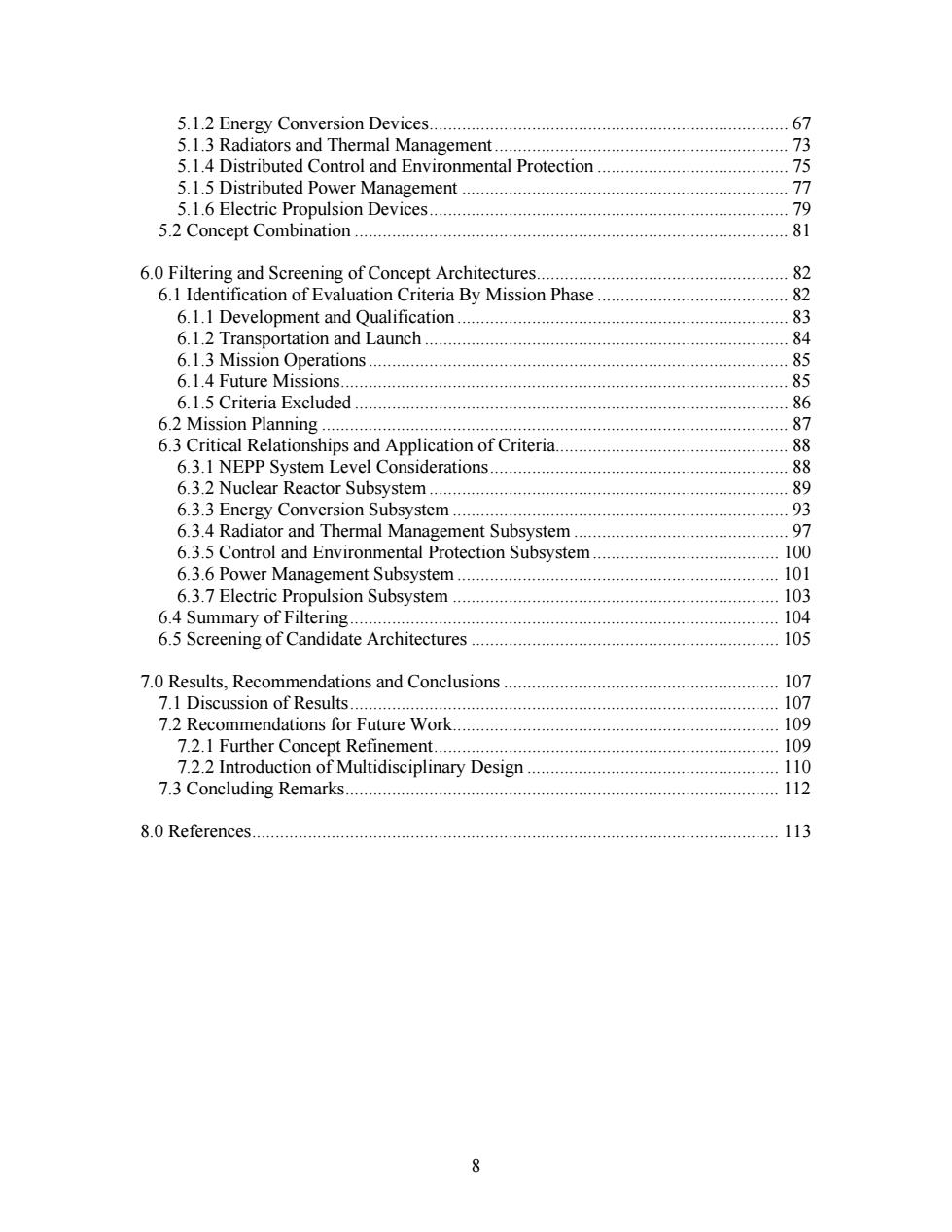
5.1.2 Energy Conversion Devices. 7 5.1.3 Radiators and Thermal Management 73 5.1.4 Distributed Control and Environmental Protection 5 5.1.5 Distributed Power Management 5.1.6 Electric Propulsion Devices............... 79 5.2 Concept Combination.. 81 6.0 Filtering and Screening of Concept Architectures. 82 6.1 Identification of Evaluation Criteria By Mission Phase 82 6.1.1 Development and Qualification................. 83 6.1.2 Transportation and Launch..... 84 6.1.3 Mission Operations..................... 5 6.1.4 Future Missions.. 85 6.1.5 Criteria Excluded. 86 6.2 Mission Planning.......... 87 6.3 Critical Relationships and Application of Criteria.... 88 6.3.1 NEPP System Level Considerations................... 88 6.3.2 Nuclear Reactor Subsystem....................... 89 6.3.3 Energy Conversion Subsystem................ 93 6.3.4 Radiator and Thermal Management Subsystem........ 97 6.3.5 Control and Environmental Protection Subsystem 100 6.3.6 Power Management Subsystem........................ 101 6.3.7 Electric Propulsion Subsystem ................. 103 6.4 Summary of Filtering.............. 104 6.5 Screening of Candidate Architectures............ 。。 105 7.0 Results,Recommendations and Conclusions....... 107 7.1 Discussion of Results.... 107 7.2 Recommendations for Future Work. 109 7.2.1 Further Concept Refinement............ 109 7.2.2 Introduction of Multidisciplinary Design 110 7.3 Concluding Remarks....... 112 8.0 References… 113 8
5.1.2 Energy Conversion Devices............................................................................. 67 5.1.3 Radiators and Thermal Management............................................................... 73 5.1.4 Distributed Control and Environmental Protection ......................................... 75 5.1.5 Distributed Power Management ...................................................................... 77 5.1.6 Electric Propulsion Devices............................................................................. 79 5.2 Concept Combination ............................................................................................. 81 6.0 Filtering and Screening of Concept Architectures...................................................... 82 6.1 Identification of Evaluation Criteria By Mission Phase ......................................... 82 6.1.1 Development and Qualification ....................................................................... 83 6.1.2 Transportation and Launch .............................................................................. 84 6.1.3 Mission Operations.......................................................................................... 85 6.1.4 Future Missions................................................................................................ 85 6.1.5 Criteria Excluded ............................................................................................. 86 6.2 Mission Planning .................................................................................................... 87 6.3 Critical Relationships and Application of Criteria.................................................. 88 6.3.1 NEPP System Level Considerations................................................................ 88 6.3.2 Nuclear Reactor Subsystem............................................................................. 89 6.3.3 Energy Conversion Subsystem ........................................................................ 93 6.3.4 Radiator and Thermal Management Subsystem .............................................. 97 6.3.5 Control and Environmental Protection Subsystem........................................ 100 6.3.6 Power Management Subsystem..................................................................... 101 6.3.7 Electric Propulsion Subsystem ...................................................................... 103 6.4 Summary of Filtering............................................................................................ 104 6.5 Screening of Candidate Architectures .................................................................. 105 7.0 Results, Recommendations and Conclusions ........................................................... 107 7.1 Discussion of Results............................................................................................ 107 7.2 Recommendations for Future Work...................................................................... 109 7.2.1 Further Concept Refinement.......................................................................... 109 7.2.2 Introduction of Multidisciplinary Design ...................................................... 110 7.3 Concluding Remarks............................................................................................. 112 8.0 References................................................................................................................. 113 8
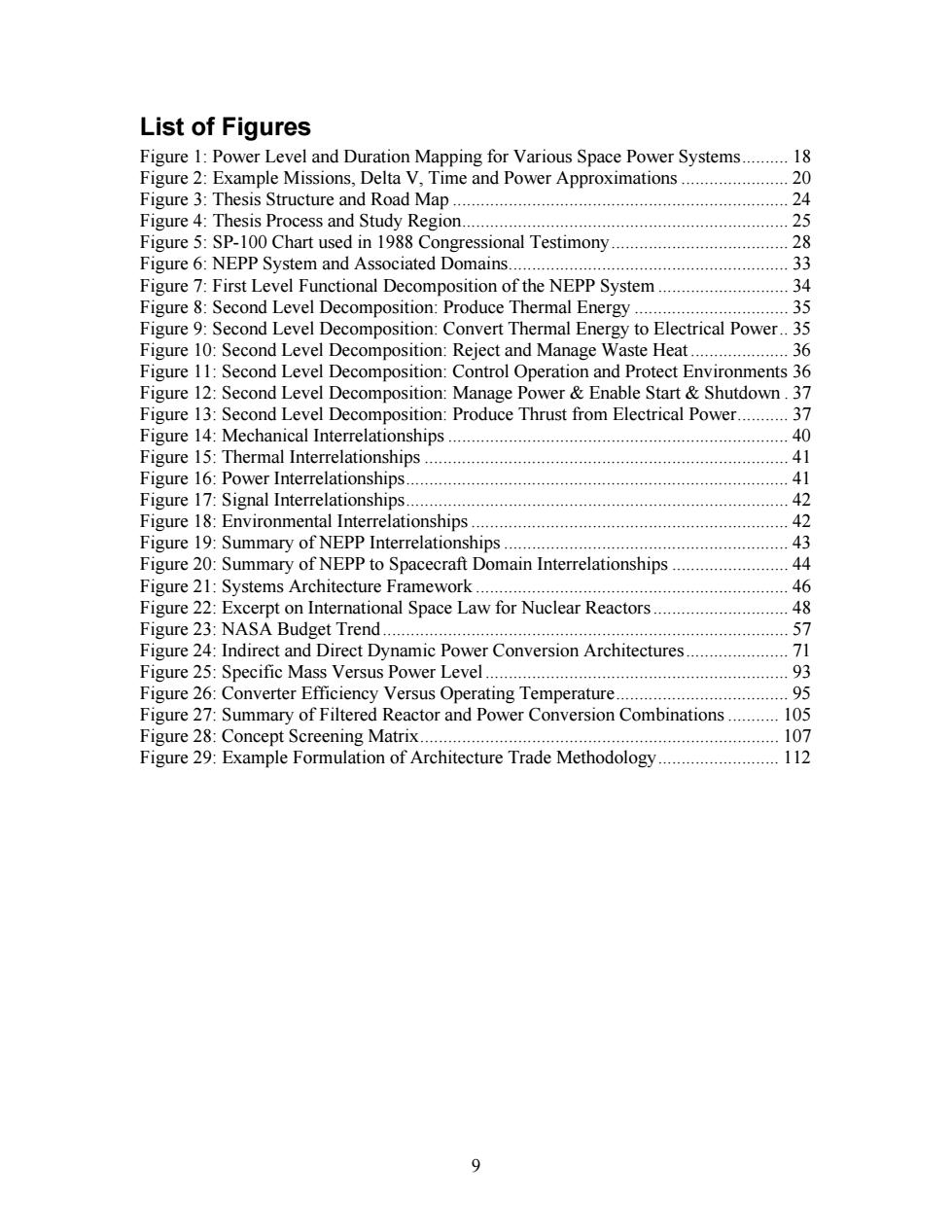
List of Figures Figure 1:Power Level and Duration Mapping for Various Space Power Systems.......... 18 Figure 2:Example Missions,Delta V,Time and Power Approximations 20 Figure 3:Thesis Structure and Road Map.................... 4 Figure 4:Thesis Process and Study Region..... 25 Figure 5:SP-100 Chart used in 1988 Congressional Testimony.................................... 28 Figure 6:NEPP System and Associated Domains.................................... 33 Figure 7:First Level Functional Decomposition of the NEPP System 34 Figure 8:Second Level Decomposition:Produce Thermal Energy............ 35 Figure 9:Second Level Decomposition:Convert Thermal Energy to Electrical Power..35 Figure 10:Second Level Decomposition:Reject and Manage Waste Heat 36 Figure 11:Second Level Decomposition:Control Operation and Protect Environments 36 Figure 12:Second Level Decomposition:Manage Power Enable Start Shutdown.37 Figure 13:Second Level Decomposition:Produce Thrust from Electrical Power. … 37 Figure 14:Mechanical Interrelationships.......... 40 Figure 15:Thermal Interrelationships 41 Figure 16:Power Interrelationships............. 41 Figure 17:Signal Interrelationships................. 42 Figure 18:Environmental Interrelationships.... 42 Figure 19:Summary of NEPP Interrelationships..... 43 Figure 20:Summary of NEPP to Spacecraft Domain Interrelationships 44 Figure 21:Systems Architecture Framework............ 46 Figure 22:Excerpt on International Space Law for Nuclear Reactors............................ 48 Figure 23:NASA Budget Trend............. 57 Figure 24:Indirect and Direct Dynamic Power Conversion Architectures 71 Figure 25:Specific Mass Versus Power Level............ 93 Figure 26:Converter Efficiency Versus Operating Temperature........ 95 Figure 27:Summary of Filtered Reactor and Power Conversion Combinations........... 105 Figure 28:Concept Screening Matrix................. 107 Figure 29:Example Formulation of Architecture Trade Methodology 112 9
List of Figures Figure 1: Power Level and Duration Mapping for Various Space Power Systems.......... 18 Figure 2: Example Missions, Delta V, Time and Power Approximations ....................... 20 Figure 3: Thesis Structure and Road Map ........................................................................ 24 Figure 4: Thesis Process and Study Region...................................................................... 25 Figure 5: SP-100 Chart used in 1988 Congressional Testimony...................................... 28 Figure 6: NEPP System and Associated Domains............................................................ 33 Figure 7: First Level Functional Decomposition of the NEPP System ............................ 34 Figure 8: Second Level Decomposition: Produce Thermal Energy ................................. 35 Figure 9: Second Level Decomposition: Convert Thermal Energy to Electrical Power.. 35 Figure 10: Second Level Decomposition: Reject and Manage Waste Heat ..................... 36 Figure 11: Second Level Decomposition: Control Operation and Protect Environments 36 Figure 12: Second Level Decomposition: Manage Power & Enable Start & Shutdown . 37 Figure 13: Second Level Decomposition: Produce Thrust from Electrical Power........... 37 Figure 14: Mechanical Interrelationships ......................................................................... 40 Figure 15: Thermal Interrelationships .............................................................................. 41 Figure 16: Power Interrelationships.................................................................................. 41 Figure 17: Signal Interrelationships.................................................................................. 42 Figure 18: Environmental Interrelationships.................................................................... 42 Figure 19: Summary of NEPP Interrelationships ............................................................. 43 Figure 20: Summary of NEPP to Spacecraft Domain Interrelationships ......................... 44 Figure 21: Systems Architecture Framework ................................................................... 46 Figure 22: Excerpt on International Space Law for Nuclear Reactors............................. 48 Figure 23: NASA Budget Trend....................................................................................... 57 Figure 24: Indirect and Direct Dynamic Power Conversion Architectures...................... 71 Figure 25: Specific Mass Versus Power Level................................................................. 93 Figure 26: Converter Efficiency Versus Operating Temperature..................................... 95 Figure 27: Summary of Filtered Reactor and Power Conversion Combinations ........... 105 Figure 28: Concept Screening Matrix............................................................................. 107 Figure 29: Example Formulation of Architecture Trade Methodology.......................... 112 9
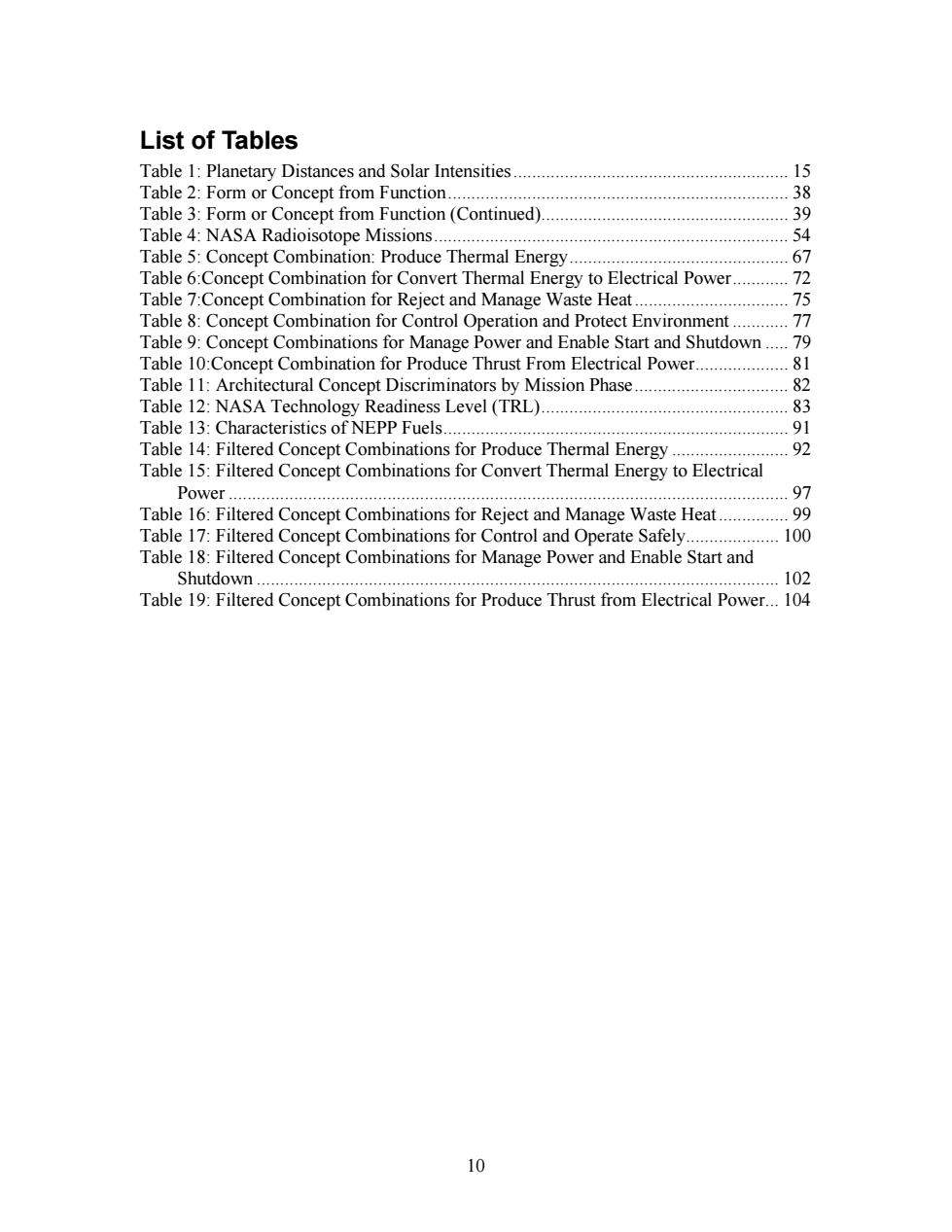
List of Tables Table 1:Planetary Distances and Solar Intensities........... .15 Table 2:Form or Concept from Function. 38 Table 3:Form or Concept from Function(Continued) 39 Table 4:NASA Radioisotope Missions........ 54 Table 5:Concept Combination:Produce Thermal Energy................................. 67 Table 6:Concept Combination for Convert Thermal Energy to Electrical Power........... 72 Table 7:Concept Combination for Reject and Manage Waste Heat....................... 75 Table 8:Concept Combination for Control Operation and Protect Environment 77 Table 9:Concept Combinations for Manage Power and Enable Start and Shutdown.....79 Table 10:Concept Combination for Produce Thrust From Electrical Power................... 81 Table 11:Architectural Concept Discriminators by Mission Phase..................... 82 Table 12:NASA Technology Readiness Level (TRL)............................................... 83 Table 13:Characteristics of NEPP Fuels........ 91 Table 14:Filtered Concept Combinations for Produce Thermal Energy..... 92 Table 15:Filtered Concept Combinations for Convert Thermal Energy to Electrical .97 Table 16:Filtered Concept Combinations for Reject and Manage Waste Heat............. 99 Table 17:Filtered Concept Combinations for Control and Operate Safely.................100 Table 18:Filtered Concept Combinations for Manage Power and Enable Start and Shutdown .102 Table 19:Filtered Concept Combinations for Produce Thrust from Electrical Power...104 10
List of Tables Table 1: Planetary Distances and Solar Intensities........................................................... 15 Table 2: Form or Concept from Function......................................................................... 38 Table 3: Form or Concept from Function (Continued)..................................................... 39 Table 4: NASA Radioisotope Missions............................................................................ 54 Table 5: Concept Combination: Produce Thermal Energy............................................... 67 Table 6:Concept Combination for Convert Thermal Energy to Electrical Power............ 72 Table 7:Concept Combination for Reject and Manage Waste Heat................................. 75 Table 8: Concept Combination for Control Operation and Protect Environment ............ 77 Table 9: Concept Combinations for Manage Power and Enable Start and Shutdown ..... 79 Table 10:Concept Combination for Produce Thrust From Electrical Power.................... 81 Table 11: Architectural Concept Discriminators by Mission Phase................................. 82 Table 12: NASA Technology Readiness Level (TRL)..................................................... 83 Table 13: Characteristics of NEPP Fuels.......................................................................... 91 Table 14: Filtered Concept Combinations for Produce Thermal Energy ......................... 92 Table 15: Filtered Concept Combinations for Convert Thermal Energy to Electrical Power ........................................................................................................................ 97 Table 16: Filtered Concept Combinations for Reject and Manage Waste Heat............... 99 Table 17: Filtered Concept Combinations for Control and Operate Safely.................... 100 Table 18: Filtered Concept Combinations for Manage Power and Enable Start and Shutdown ................................................................................................................ 102 Table 19: Filtered Concept Combinations for Produce Thrust from Electrical Power... 104 10
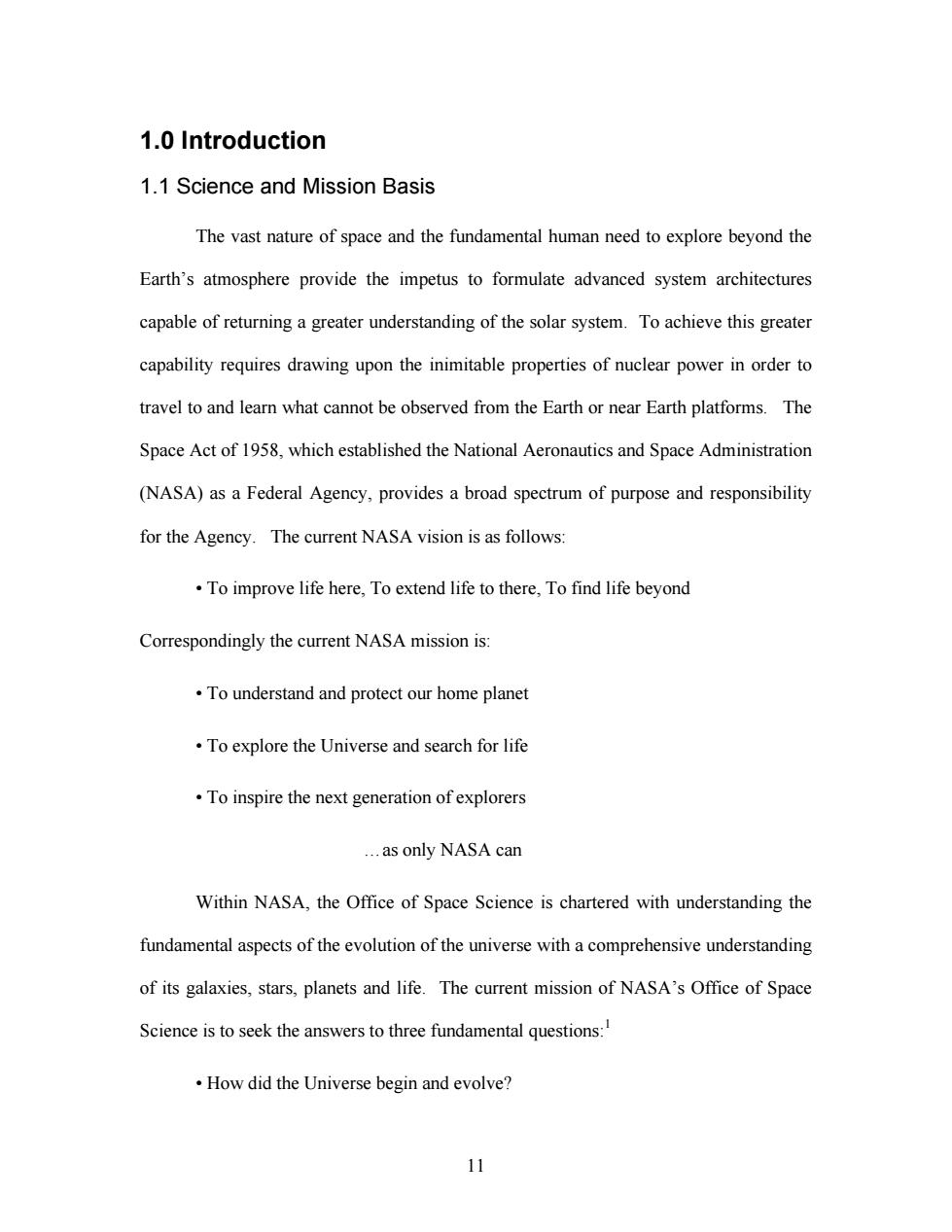
1.0 Introduction 1.1 Science and Mission Basis The vast nature of space and the fundamental human need to explore beyond the Earth's atmosphere provide the impetus to formulate advanced system architectures capable of returning a greater understanding of the solar system.To achieve this greater capability requires drawing upon the inimitable properties of nuclear power in order to travel to and learn what cannot be observed from the Earth or near Earth platforms.The Space Act of 1958,which established the National Aeronautics and Space Administration (NASA)as a Federal Agency,provides a broad spectrum of purpose and responsibility for the Agency.The current NASA vision is as follows: To improve life here,To extend life to there,To find life beyond Correspondingly the current NASA mission is: To understand and protect our home planet To explore the Universe and search for life To inspire the next generation of explorers ..as only NASA can Within NASA,the Office of Space Science is chartered with understanding the fundamental aspects of the evolution of the universe with a comprehensive understanding of its galaxies,stars,planets and life.The current mission of NASA's Office of Space Science is to seek the answers to three fundamental questions: How did the Universe begin and evolve? 11
1.0 Introduction 1.1 Science and Mission Basis The vast nature of space and the fundamental human need to explore beyond the Earth’s atmosphere provide the impetus to formulate advanced system architectures capable of returning a greater understanding of the solar system. To achieve this greater capability requires drawing upon the inimitable properties of nuclear power in order to travel to and learn what cannot be observed from the Earth or near Earth platforms. The Space Act of 1958, which established the National Aeronautics and Space Administration (NASA) as a Federal Agency, provides a broad spectrum of purpose and responsibility for the Agency. The current NASA vision is as follows: • To improve life here, To extend life to there, To find life beyond Correspondingly the current NASA mission is: • To understand and protect our home planet • To explore the Universe and search for life • To inspire the next generation of explorers …as only NASA can Within NASA, the Office of Space Science is chartered with understanding the fundamental aspects of the evolution of the universe with a comprehensive understanding of its galaxies, stars, planets and life. The current mission of NASA’s Office of Space Science is to seek the answers to three fundamental questions:1 • How did the Universe begin and evolve? 11